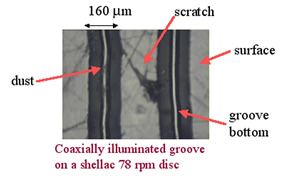Thomas Edison invented the phonograph in 1877, recording sound for the first time when he spoke the words “Mary had a little lamb” onto a vertically embossed tinfoil cylinder. In the following years, sound was recorded on diverse media – tin foil, wax and plastic cylinders, shellac and vinyl discs, acetate sheets, and plastic dictation belts. The problem with restoring audio recordings on these materials has been that many are now over a hundred years old and often are damaged, scarred, or broken. Current restoration processes would damage or destroy them. That has now changed. Berkeley Lab has developed the Optical Sound Restoration (OSR) System that can recover audio data without any physical contact with the fragile discs and cylinders.

The science that inspired the technology
The Berkeley Lab Optical Sound Restoration System is the first technology to provide non-contact restoration of recording on all types of mechanical sound carriers. Depending on the medium to be restored, the technology produces either 2 dimensional or 3 dimensional optical digital images, creating a map of the entire groove profile of a disc or cylinder. It uses computer algorithms to emulate the stylus motion, select undamaged portions of the groove, and reconstruct the audio waveform.
The physicists who invented the OSR system, Carl Haber and Vitaliy Fadeyev, normally work on developing silicon sensor arrays to track particles in high energy physics experiments. “We thought these methods, which demand pattern recognition and noise suppression, could also analyze and reconstruct data from the recording grooves in mechanical recordings,” says Haber.

The technology transfer process
Haber and Fadeyev discussed their idea with staff in Berkeley Lab’s Technology Transfer Department and received a five thousand dollar technology maturation grant to finish the first round of studies and publish their results. The scientists sent the publication to the Library of Congress and other institutions with large audio collections. Their efforts and the subsequent interest of the Library of Congress has led over $600,000 in funding from The National Endowment for the Humanities, The Library of Congress, and The National Archives and Records Administration and the Department of Energy. With this funding, Berkeley Lab is now working with the Library of Congress to build an OSR system for preserving our national audio treasures.
The home page for the Berkeley Lab OSR System has a number of recordings made using the technology as well as presentations and papers. The URL is: http://irene.lbl.gov/

